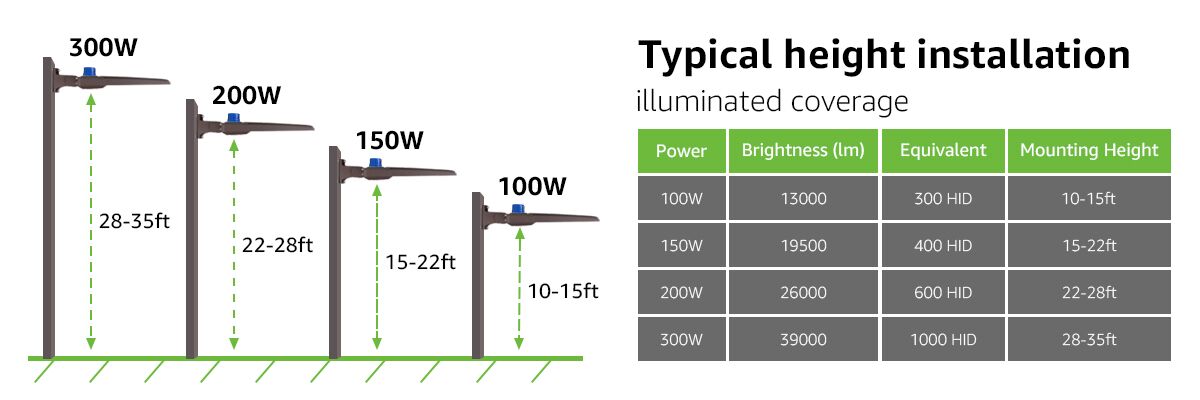Parking lot lighting is outdoor lighting that is specifically designed to illuminate parking lots, pathways, roadways, and pedestrian walkways. The correct parking lot lighting will create a feeling of comfort and safety while never causing eye strain. Knowing about the Coverage Area of a Parking Lot Light is crucial to achieving a safe environment for customers, visitors, and employees.
How Many Feet does a Shoebox Light Cover?
The appropriate mounting height of parking lot lights usually ranges anywhere from 12 feet to 20 feet, though in some cases, poles can reach heights of up to 35 feet. Generally, the size of the parking lot determines the height of the light poles.

How Many Lights do You Need for Your Parking Lot
On average, two LED parking lot lighting heads of 20,000 lumens each at a height level of between 15 and 20 feet is appropriate. Here, poles are typically kept about 20 feet apart. However, to determine the correct number of lights for your specific parking lot, you can focus on foot-candle and uniformity. A foot-candle is a measurement of the amount of light that reaches a surface area. Light uniformity is expressed as the ratio of maximum to minimum illumination. Currently, the recommended ratio for most outdoor parking lots is 3:1. When lighting lacks uniformity, this is often due to too much space between the fixtures. Alternatively, other features, like trees, may complicate uniformity.
The type of poles across your parking lot can also influence the number of lights that should be used. As a rule of thumb, the size of the parking lot will determine the recommended height of your poles. For larger areas, tall poles are preferred, and vice versa. It is recommended that first, you determine the height of the pole to use, then you decide on the spacing of your fixtures. Typically, the higher the mounting height, the fewer poles you need!
Do LED Parking Lot Lights Cover More Area?
No, LEDs might be brighter, but they do not always cover more area.
LED fixtures can help you to design a layout that provides optimum light coverage. LEDs have patterns that, when projected onto an object or surface, determine how light is dispersed from an illumination fixture. This is defined as the point at which 50% of the fixture’s luminous intensity is met. These distributions are an optimal choice to meet parking lot needs.
LED Shoebox Light Pattern Distributions
A Type I pattern achieves a wide, symmetrical light – perfect for fixtures in the middle of a walkway.
As Type II light fixtures effectuate a slightly lower distribution, they are primarily intended to be placed at the side of a roadway or as street lighting.
Type III light distributions cast light about 2.75 times wider than the mounting height of the fixture.
Type IV light distribution fixtures are also known as asymmetrical fixtures. Like Type IIIs, they cast light 2.75 wider than their heights, but as they generate a much more rounded distribution pattern that pushes outward, little light falls behind the fixture.
Type V light distribution fixtures are also called omnidirectional fixtures. They distribute light evenly in a uniform or circle around the fixture. Click for more information about Light Distribution Types for Parking Lot Lights.
LED Parking Lot Light Coverage Area Charts
The parking lot light chosen most frequently is T3, short for Type III. It is the de-facto standard in the parking lot lighting arena and has proven itself an effective choice for many years. Example measurements can be seen in the light type chart below: at 140 degrees wide, 90 degrees forward, and 20 feet high, that is about 46 feet wide and 28 feet forward.
Additionally, it is clearly visible where the foot candles drop off. This helps us to determine where the next light should be placed. In the example, at a 20-foot height, the next light should probably be located around 30 feet away to maintain an even 8-foot candle along the side of the road. If an alternating dark-light pattern is acceptable, you could move the next pole 40-50 feet away, but this would mean going from 7fc down to 2fc and then back to 7fc. Generally fine for back lots, it is not recommended for parking lot lighting.
How is the Parking Lot Light Coverage Area Calculated?
The parking lot coverage area is easily calculated by multiplying the parking lot’s square footage by the foot-candle requirement. For instance, a parking lot the size of 100 square feet, needing 20 foot-candles, will require 2,000 lumens.
LED Shoebox Light Lumens, Wattage, and Footcandle
It is crucial that you pay attention to wattage lumens and foot candles. LED shoebox lights provide more lumen output per watt. For efficient lighting, this is what matters. If you require the lighting to cover between 15 and 20 feet, it is best to look for an output of between 16,000 and 20,000 lumens. By contrast, if you wish to cover 20 to 30 feet, 40,000 lumens should suffice. Therefore, when looking for the most appropriate LED parking lot lights, your focus must be on lumens, a unit of measurement of brightness provided by the light! The brightness of LEDs is also determined by lumens.
Footcandles, on the other hand, are the most common unit of measurement used to calculate light levels across outdoor spaces. A foot-candle can be defined as the luminance of a surface area of one square foot from a uniform source of light. Thus, it is a measure of the amount of light that reaches a specific surface area. From a candlelit source, light falling onto one square foot equals one lumen per square foot. The shape and coverage of an area are the main determinants of an adequate level of light. Lighting experts typically recommend a minimum light level of 1fc across the desired area, with 2fc to 4fc being more desirable for the purposes of appeal and optimal visibility.




